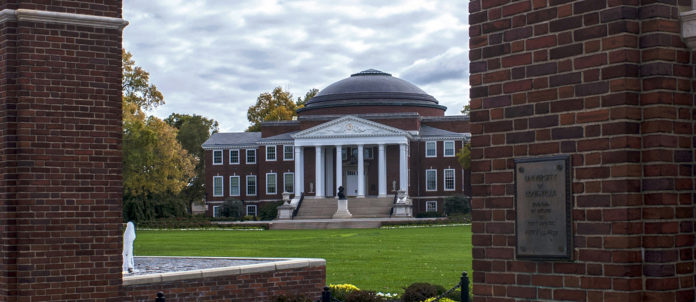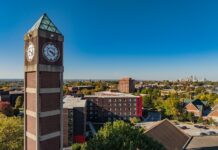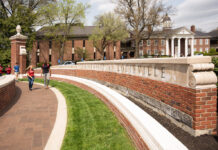
On April 3, 1798, eight Louisvillians declared their intention to establish the Jefferson Seminary and began soliciting funds to buy the necessary land, buildings and other expenses to bring this institution to fruition. According to “The University of Louisville,” by Dwayne D. Cox and William J. Morison, their efforts were the first steps in the creation of the modern-day University of Louisville.
Accordingly, April 3 is known as “Founders Day” at UofL.
The original eight founders were prominent members of the community and many of their names may sound familiar – Richard Clough Anderson, Alexander S. Bullitt, William Croghan, John Thruston, William Taylor, James Meriwether, Henry Churchill and John Thompson.
Their call for action was preceded by the Kentucky General Assembly’s Act for the Endowment of Certain Seminaries of Learning. The network was comprised of six academies, including the proposed Jefferson Seminary. Despite the name, no religious connotation was implied. Conversely, it was among the earliest academies in the commonwealth not administered by a religious body, according to the book.
The group received a land grand of 6,000 acres and the eight men were appointed trustees.
“With their April 3, 1798 announcement of the fundraising campaign, the work to establish Jefferson Seminary could begin in earnest. They themselves pledged $715,” the book reads.
However, within the first three years, the trustees had nothing to show for their fundraising efforts. The legislature doubled the size of the trustees, adding Robert Breckinridge, Fortunatus Cosby, Abner Field, Abraham Hite, Gabriel J. Jonston, James F. Moore, Samuel Oldham and John Speed.
But with continued stagnancy, another board reorganization happened in 1804 and, again, in 1808.
The Jefferson Seminary finally opened in the fall of 1813 in temporary quarters, moving to a permanent building downtown the next year. Tuition for that first year was about $20, and curriculum included English, French, Latin, Greek geography, and trigonometry as applied to surveying and navigation. The school was co-ed.
Second iteration: 1837 or 1846?
High faculty turnover, internal dissent, public resentment over the curriculum, and financial instability hindered the school’s growth in the early years. In 1829, the Jefferson Seminary closed for good.
In 1837, the city established the Louisville Medical Institute and the Louisville Collegiate Institute “for the purpose of educating students beyond high school,” the book reads. Shortly after, the Collegiate Institute changed its name to Louisville College.
By 1846, Louisville College and the Louisville Medical Institute were combined and a law school was added to form the University of Louisville.
Prior to the 1930s, the founding date featured on the university seal was 1846, when the institution acquired the University of Louisville name. UofL president Raymond A. Kent – who held that role from 1929-1943 – launched a campaign that included changing the school’s official founding date from 1846 back to 1837.
A “Founders Day Celebration” was held on April 3, 1932 to mark the institutions “95th anniversary,” and a centennial celebration was held five years later, in 1937.
However, 11 years after that centennial celebration, in 1948, the university held another event to mark its 150th anniversary after a local attorney gathered enough historical evidence that supported 1798 as UofL’s “real date of origin.”
Confusion and humor ensued. The July 30, 1947, Courier-Journal reported that UofL “had aged 39 years in a day” and even Time magazine joked about the university’s founding date inconsistencies, according to the book.
UofL itself held its resolve in linking its history to the Jefferson Seminary, and the university’s seal was even changed to read, “chartered in 1798.”
According to “The University of Louisville,” only two of the original trustees of Jefferson Seminary lived to see it close in 1829. One remained when its successor school, Louisville Collegiate Institute, was established in 1837. None witnessed the creation of the University of Louisville proper in 1846 …
“But they did fashion an academy where none existed before … and they wanted a community that valued education. Their confident declaration of April 3, 1798, was the genesis of the vision from which a modern university grew.”
Additional milestones
- 1907, the revival of the liberal arts college
- 1915, Graduate School added
- 1918, School of Dentistry added
- 1919, School of Public Health added
- 1925, Speed Scientific School added
- 1932, School of Music added
- 1936, Kent School of Social Work added
- 1937, the Department of Fine Arts added; endowed as the Hite Art Institute in 1946
- 1950-51, the university was desegregated and the all-black Louisville Municipal College closed
- 1953, School of Business added
- 1968, School of Education added
- 1969, School of Justice Administration added
- 1970, UofL joins the state system of higher education
- 1979, School of Nursing added
- 1983, College of Urban and Public Affairs added
- 1997, the law school is renamed the Brandeis School of Law
- 2001, School of Education becomes the College of Education and Human Development
- 2002, the School of Public Health and Information Sciences is reconstituted, growing out of the Institute for Public Health Research originally created in 1998
- 2003, Speed Scientific School renamed the Speed School of Engineering

































